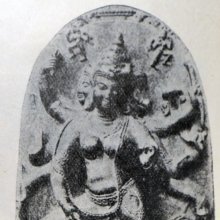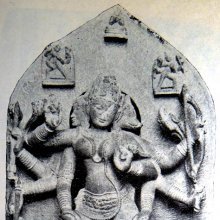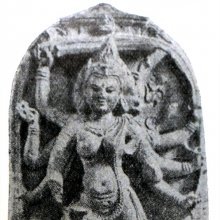Indranila, Indranīla, Indra-nila, Imdranila: 22 definitions
Introduction:
Indranila means something in Buddhism, Pali, Hinduism, Sanskrit, Jainism, Prakrit, Marathi. If you want to know the exact meaning, history, etymology or English translation of this term then check out the descriptions on this page. Add your comment or reference to a book if you want to contribute to this summary article.
Images (photo gallery)
In Hinduism
Vastushastra (architecture)
Source: Wisdom Library: Vāstu-śāstraIndranīla (इन्द्रनील) refers to a type of temple (prāsāda) classified under the group named Sāndhāra, according to Samarāṅgaṇasūtradhāra chapter 56. The Sāndhāra group contains twenty-five out of a sixty-four total prāsādas (temples) classified under four groups in this chapter. The Samarāṅgaṇasūtradhāra is an 11th-century encyclopedia dealing with various topics from the Vāstuśāstra.

Vastushastra (वास्तुशास्त्र, vāstuśāstra) refers to the ancient Indian science (shastra) of architecture (vastu), dealing with topics such architecture, sculpture, town-building, fort building and various other constructions. Vastu also deals with the philosophy of the architectural relation with the cosmic universe.
Purana and Itihasa (epic history)
Source: archive.org: Shiva Purana - English TranslationIndranīla (इन्द्रनील) refers to a “sapphire”, representing the material of Viṣṇu’s liṅga, according to the Śivapurāṇa 2.1.12, where the Devas and Viṣṇu requested Viśvakarman for liṅgas for the achievement of the desires of all people:—“[...] at our bidding Viśvakarmā made liṅgas and gave them to the devas according to their status. [...] Dharma took a liṅga of yellow stone, Varuṇa took a liṅga of dark blue hue. Viṣṇu took a liṅga of sapphire (Indranīla-liṅga). I, Brahmā, took a liṅga of gold. [...] Thus different kinds of liṅgas were given to them by Viśvakarmā which the devas and the celestial sages worship regularly. After giving the devas the various liṅgas from a desire for their benefit, Viṣṇu explained the mode of worship of Śiva to me, Brahmā”.

The Purana (पुराण, purāṇas) refers to Sanskrit literature preserving ancient India’s vast cultural history, including historical legends, religious ceremonies, various arts and sciences. The eighteen mahapuranas total over 400,000 shlokas (metrical couplets) and date to at least several centuries BCE.
Shaktism (Shakta philosophy)
Source: Google Books: ManthanabhairavatantramIndranīla (इन्द्रनील) refers to “(cities with pillars of) sapphire”, according to the Ṣaṭsāhasrasaṃhitā, an expansion of the Kubjikāmatatantra: the earliest popular and most authoritative Tantra of the Kubjikā cult.—Accordingly, “[...] O goddess, I will (now) tell you about the god of Kāmarūpa. (His) city is fashioned all around with pillars of sapphire [i.e., indranīla—indranīlamayaiḥ stambhaiḥ]. It has palaces, mansions, arches, banners, goads, and bows. The god holds five arrows and is accompanied by Kāmeśvarī. Without a body and in the form of light, he melts away the entire universe. He is the lord of the fourteen worlds and holds the staff (of authority). Everything, including passion and the rest, takes place impelled by his will. Thus, it is located in the foremost portion, above Mind Beyond Mind. O Pārvatī, one should meditate on it above the Cavity of Brahmā within the End of the Twelve”.

Shakta (शाक्त, śākta) or Shaktism (śāktism) represents a tradition of Hinduism where the Goddess (Devi) is revered and worshipped. Shakta literature includes a range of scriptures, including various Agamas and Tantras, although its roots may be traced back to the Vedas.
Shaivism (Shaiva philosophy)
Source: SOAS University of London: Protective Rites in the Netra TantraIndranīla (इन्द्रनील) refers to a “sapphire”, according to the Netratantra of Kṣemarāja: a Śaiva text from the 9th century in which Śiva (Bhairava) teaches Pārvatī topics such as metaphysics, cosmology, and soteriology.—Accordingly, [verse 11.1-24ab, while describing the appearance and worship of Tumburu]—“[...] The Devīs are white, red, yellow, and black, four-faced, four armed, three eyed, and in [their] hands bear golden hatchets, sticks and rosaries. [...] Seated on horseback, the Great Devī [Aparājitā] is adorned with many ornaments and resembles a broken sapphire (bhinna-indranīla-sadṛśī) [i.e., black]. [She is] adorned with four faces, four arms, three eyes, and holds a grass noose, a jewel, a bowl, and a mace. [She] stands firmly on a divine seat, clothed in gold clothes and gold ornaments. [...] [When one] worships and meditates on [the Devīs, as they] stand in the cardinal directions, [the Devīs grant the practitioner] the fruits of siddhi. [...]”.

Shaiva (शैव, śaiva) or Shaivism (śaivism) represents a tradition of Hinduism worshiping Shiva as the supreme being. Closely related to Shaktism, Shaiva literature includes a range of scriptures, including Tantras, while the root of this tradition may be traced back to the ancient Vedas.
Ayurveda (science of life)
Rasashastra (Alchemy and Herbo-Mineral preparations)
Source: History of Science in South Asia: Making Gems in Indian Alchemical LiteratureIndranīla (इन्द्रनील) refers to “sapphires” for which alchemical formulas are provided in order to create these gems, according to the Vādakhaṇḍa section of the Rasaratnākara (lit. “jewel mine of mercury”): a 13th century alchemical work in Sanskrit written by Nityanātha.—Verses 1-40 of chapter 19 continues with a series of formulations for creating gems. These formulations stand on their own and do not seem to be integrated into a larger alchemical programme of making mercurial elixirs. The gems to be created include [sapphires (indranīla)], [...] None of the recipes for producing these gems are found in any other Sanskrit alchemical work.

Āyurveda (आयुर्वेद, ayurveda) is a branch of Indian science dealing with medicine, herbalism, taxology, anatomy, surgery, alchemy and related topics. Traditional practice of Āyurveda in ancient India dates back to at least the first millenium BC. Literature is commonly written in Sanskrit using various poetic metres.
General definition (in Hinduism)
Source: Wisdom Library: HinduismIndranīla (इन्द्रनील):—One of the variations of the Sapphire (or, nīlamaṇi, one of the nine gems (navaratna)). It looks beautiful and black from inside and blue on the outer side. This variation is also known as the Śakranīla.
In Buddhism
Mahayana (major branch of Buddhism)
Source: academia.edu: A Study and Translation of the GaganagañjaparipṛcchāIndranīla (इन्द्रनील) (Tibetan: iṇ ḍra ñila) refers to the “sapphire” (a type of jewel or precious stone, according to the Gaganagañjaparipṛcchā: the eighth chapter of the Mahāsaṃnipāta (a collection of Mahāyāna Buddhist Sūtras).—Accordingly: “[...] Then the Bodhisattva Ratnavyūha said to the Bodhisattva Gaganagañja: ‘Son of good family, please pour down rain of all kinds of jewels from the sky’. Immediately after his words, the great rain of immeasurable, incalculable amount of jewels, equal to Mount Sumeru in size, with various kinds of names and colors, poured down from ten directions. To wit, [...] conch shell, crystal, red coral, sapphire (indranīla), Guṇākara gem, calm light gem, water-light gem, water-like gem, transparent gem, earthy light gem, indestructible gem, blinding gem, Śakra-holding gem, victor’s gem, the great victor’s gem, [...]”.

Mahayana (महायान, mahāyāna) is a major branch of Buddhism focusing on the path of a Bodhisattva (spiritual aspirants/ enlightened beings). Extant literature is vast and primarely composed in the Sanskrit language. There are many sūtras of which some of the earliest are the various Prajñāpāramitā sūtras.
Tibetan Buddhism (Vajrayana or tantric Buddhism)
Source: Brill: Śaivism and the Tantric Traditions (tantric Buddhism)Indranīla (इन्द्रनील) refers to the “sapphires”, according to the Nāmamantrārthāvalokinī by Vilāsavajra, which is a commentary on the Nāmasaṃgīti.—Accordingly, [while describing Mañjuśrī-jñānasattva]—“[Next] he should visualise himself as the fortunate one, the gnosis-being [Mañjuśrī], born from the syllable a situated in the middle of that [wisdom-] wheel [situated in the heart of the Ādibuddha]. He has six faces, is radiant like the autumn moon, with the best of sapphires in his beautiful hair (indranīla-agra-saccīra), with a halo that has the brilliance of the orb of the newly risen sun, with all the tathāgatas as [head-]ornaments, immersed in meditative concentration, seated on a variagated lotus throne, in tranquil mood, with a pair of books of the Prajñāpāramitā above blue lotuses held in his two hands”.
Source: OSU Press: Cakrasamvara SamadhiIndranīla (इन्द्रनील) refers to a “sapphire”, according to the Guru Mandala Worship (maṇḍalārcana) ritual often performed in combination with the Cakrasaṃvara Samādhi, which refers to the primary pūjā and sādhanā practice of Newah Mahāyāna-Vajrayāna Buddhists in Nepal.—Accordingly, “Oṃ in the middle of mantra inhabited ground, arisen of the four seeds, yaṃ, etc., a maṇḍala of the great elements, wind, fire, water, and earth, Above that, (arising from) the letter suṃ, is the merumaṇḍala, Above that, on a jeweled lion-throne, lotus, and a lunar-disc, Śrī Vajrasattva, two arms, one face, white color, Holding a vajra (and) vajra-bell, (and) adorned wearing various colors, Bearing a monk’s headdress, (and) a sapphire (indranīla) Akṣobhya adorned crown, Thus imagine the worshipful guru. [...]”.

Tibetan Buddhism includes schools such as Nyingma, Kadampa, Kagyu and Gelug. Their primary canon of literature is divided in two broad categories: The Kangyur, which consists of Buddha’s words, and the Tengyur, which includes commentaries from various sources. Esotericism and tantra techniques (vajrayāna) are collected indepently.
In Jainism
Jain philosophy
Source: archive.org: Anekanta Jaya Pataka of Haribhadra SuriIndranīla (इन्द्रनील) refers to a kind of jewel known as ‘Sapphire’, as occurring in the Anekāntajayapatākā-prakaraṇa, a Śvetāmbara Jain philosophical work written by Haribhadra Sūri.—[Cf. Vol. I, P. 182, l. 3]—‘Indranīla’ is a kind of jewel known as ‘Sapphire’. This word occurs on p. 183, l. 4, & p. 186, l. 15, and it is met with in Mṛcchakatika (IV, p 132) and Kādambarī (pūrvabhāga, p. 53 of P. V. Kane’s edition). For names of other jewels see Lokaprakāśa (V, 9-11), Abhidhānacintāmaṇi (IV, 129-134) and Mṛcchakaṭīkā (IV, pp. 131-132).
-
General definition (in Jainism)
Source: archive.org: Economic Life In Ancient India (as depicted in Jain canonical literature)Indranīla (इन्द्रनील) refers to “sapphire”, and is the name of a type of precious stone (gem or jewel) typically used in ancient India. Both the king (rājan) and the people used to keep previous stones as a part of their wealth and affluence. The king’s mansion was studded with precious stones of various kinds. The rich people possessed them in large quantity and used them in ornaments and for other purposes. The courtesans (gaṇiya) possessed costly jewels and their chambers were adorned with precious jewels. The palanquins of the kings, nobles and rich persons (śreṣṭhins) were inlaid with costly gems.
There were persons expert in the field of gem and jewels (e.g., indranīla) called maṇikāras (jewellers). There is a reference of maṇikāra-śreṣṭhin in Rājagṛha who had abundant gems and jewels. Various ornaments of pearls and jewels are mentioned in the texts viz. Kaṇagāvali (necklace of gold and gems), rayaṇāvali (necklace of jewels), muttāvali (necklace of pearls), etc. The above description of the various agricultural, agro-based, mining or forestry occupations clearly depicts the high level of perfection achieved in the respective fields.

Jainism is an Indian religion of Dharma whose doctrine revolves around harmlessness (ahimsa) towards every living being. The two major branches (Digambara and Svetambara) of Jainism stimulate self-control (or, shramana, ‘self-reliance’) and spiritual development through a path of peace for the soul to progess to the ultimate goal.
Languages of India and abroad
Marathi-English dictionary
Source: DDSA: The Molesworth Marathi and English Dictionaryindranīla (इंद्रनील).—m S A sapphire.
Source: DDSA: The Aryabhusan school dictionary, Marathi-Englishindranīla (इंद्रनील).—m A sapphire.
Marathi is an Indo-European language having over 70 million native speakers people in (predominantly) Maharashtra India. Marathi, like many other Indo-Aryan languages, evolved from early forms of Prakrit, which itself is a subset of Sanskrit, one of the most ancient languages of the world.
Sanskrit dictionary
Source: DDSA: The practical Sanskrit-English dictionaryIndranīla (इन्द्रनील).—[indra iva nīlaḥ śyāmaḥ] a sapphire; परीक्षाप्रत्ययैर्यैश्च पद्मरागः परीक्ष्यते । त एव प्रत्यया दृष्टा इन्द्रनीलमणेरपि (parīkṣāpratyayairyaiśca padmarāgaḥ parīkṣyate | ta eva pratyayā dṛṣṭā indranīlamaṇerapi) || Garuḍa. P.; R.13.54;16.69; Meghadūta 48,79.
Derivable forms: indranīlaḥ (इन्द्रनीलः).
Indranīla is a Sanskrit compound consisting of the terms indra and nīla (नील).
Source: Cologne Digital Sanskrit Dictionaries: Shabda-Sagara Sanskrit-English DictionaryIndranīla (इन्द्रनील).—m.
(-laḥ) A sapphire. E. indra best, and nīla blue.
Source: Cologne Digital Sanskrit Dictionaries: Benfey Sanskrit-English DictionaryIndranīla (इन्द्रनील).—m. a sapphire, [Meghadūta, (ed. Gildemeister.)] 47.
Indranīla is a Sanskrit compound consisting of the terms indra and nīla (नील).
Source: Cologne Digital Sanskrit Dictionaries: Cappeller Sanskrit-English DictionaryIndranīla (इन्द्रनील).—[masculine] sapphire.
Source: Cologne Digital Sanskrit Dictionaries: Monier-Williams Sanskrit-English DictionaryIndranīla (इन्द्रनील):—[=indra-nīla] [from indra] m. a sapphire, [Raghuvaṃśa; Meghadūta; Śiśupāla-vadha; Bhāgavata-purāṇa]
Source: Cologne Digital Sanskrit Dictionaries: Yates Sanskrit-English DictionaryIndranīla (इन्द्रनील):—[indra-nīla] (laḥ) 1. m. A sapphire.
[Sanskrit to German]
Sanskrit, also spelled संस्कृतम् (saṃskṛtam), is an ancient language of India commonly seen as the grandmother of the Indo-European language family (even English!). Closely allied with Prakrit and Pali, Sanskrit is more exhaustive in both grammar and terms and has the most extensive collection of literature in the world, greatly surpassing its sister-languages Greek and Latin.
Kannada-English dictionary
Source: Alar: Kannada-English corpusIṃdranīla (ಇಂದ್ರನೀಲ):—[noun] a brilliant precious variety of corundum of beautiful blue; sapphire.
Kannada is a Dravidian language (as opposed to the Indo-European language family) mainly spoken in the southwestern region of India.
See also (Relevant definitions)
Starts with: Imdranilaya, Indranilagra, Indranilaka, Indranilalinga, Indranilamaya, Indranilavarna.
Ends with: Aindranila, Bhinnendranila.
Full-text (+4): Aindranila, Indranilaka, Imdramani, Unmayukha, Asitashman, Apadika, Indranilamaya, Manishyama, Navaratnem, Bhadrasoma, Shakranila, Sapphire, Padmanabha, Sandhara, Galvarka, Nyasamantra, Varaha, Karkataka, Mahanila, Bhinna.
Relevant text
Search found 26 books and stories containing Indranila, Indranīla, Indra-nila, Indra-nīla, Imdranila, Iṃdranīla; (plurals include: Indranilas, Indranīlas, nilas, nīlas, Imdranilas, Iṃdranīlas). You can also click to the full overview containing English textual excerpts. Below are direct links for the most relevant articles:
The Garuda Purana (by Manmatha Nath Dutt)
Chapter LXXII - Tests of Sapphires < [Agastya Samhita]
Chapter LXXIV - Tests of topas (puspa-raga) < [Agastya Samhita]
Chapter LXX - Tests of Ruby < [Agastya Samhita]
Rasa Jala Nidhi, vol 3: Metals, Gems and other substances (by Bhudeb Mookerjee)
Part 1 - Characteristics of Sapphire (nila) < [Chapter XVII - Gems (5): Nila (sapphire)]
Part 2 - Uparatna (2): Rudhra (carnelian) < [Chapter XXVII - Uparatna (minor gems)]
Cosmetics, Costumes and Ornaments in Ancient India (by Remadevi. O.)
1.2. Materials (e): Indranīla (Sapphire) < [Chapter 3 - Ornaments]
1.2. Materials: Gems (Introduction) < [Chapter 3 - Ornaments]
Sahitya-kaumudi by Baladeva Vidyabhushana (by Gaurapada Dāsa)
Text 9.26 < [Chapter 9 - Ornaments of Sound]
Text 10.54 < [Chapter 10 - Ornaments of Meaning]
Text 4.39 < [Chapter 4 - First-rate Poetry]
Chaitanya Bhagavata (by Bhumipati Dāsa)
Verse 1.7.190 < [Chapter 7 - Śrī Viśvarūpa Takes Sannyāsa]
Garga Samhita (English) (by Danavir Goswami)
Verses 5.3.11-12 < [Chapter 3 - Akrūra’s Arrival]



